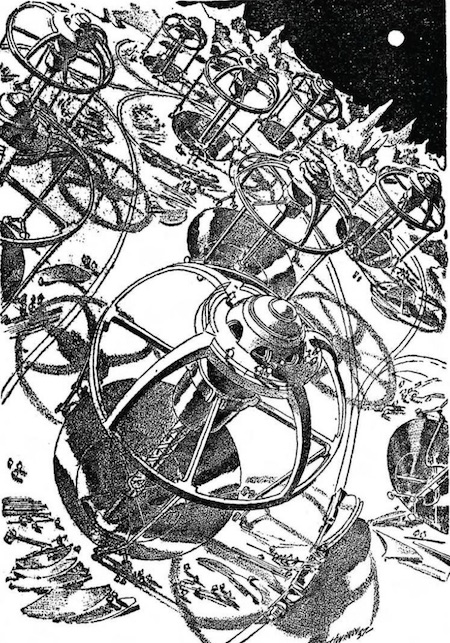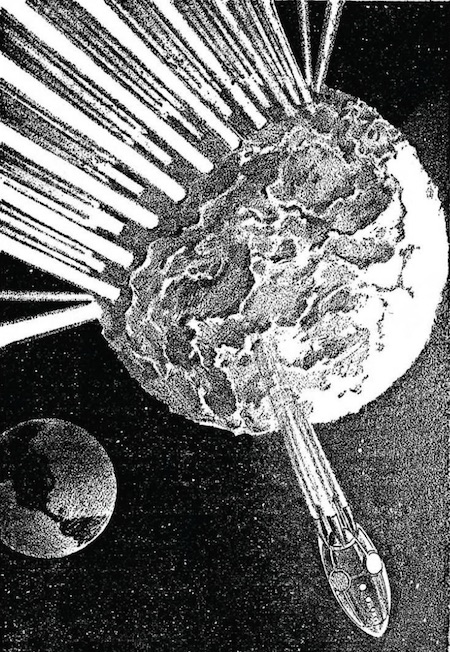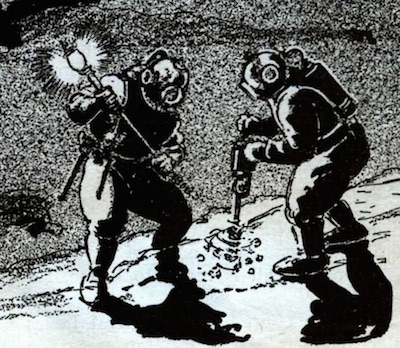Science Fiction
Dictionary
A B C D E F G H I J K L M N O P Q R S T U V W X Y Z
Latest By
Category:
Armor
Artificial
Intelligence
Biology
Clothing
Communication
Computers
Culture
Data Storage
Displays
Engineering
Entertainment
Food
Input Devices
Lifestyle
Living Space
Manufacturing
Material
Media
Medical
Miscellaneous
Robotics
Security
Space Tech
Spacecraft
Surveillance
Transportation
Travel
Vehicle
Virtual
Person
Warfare
Weapon
Work
"What I have in my stories is ethics. Ethics and morality are very different cups of tea. I adhere to a very strict rigor of personal ethics and I demand it of those around me as well."
- Harlan Ellison
| Atomic Drill | ||
| An atomic-powered auger, for use in drilling deep into planets and asteroids. |
| “There's one projectile available that would be big enough to make quite a perceptible dent in its path: the Moon! We can spare it. All it does is produce the tides. Mount rocket tubes on the Moon, pry it up out of the solar system, and sock the intruder so that its course will be changed and it will fall into the Sun! We can do that if we hit it while it’s still far enough away from the system.”
 (Atomic drills in 'Minus Planet' by John Clark) ...the huge atomic drills, operated by men in space suits, started the excavation of the deep shafts that were to act as rocket tubes. Some fifty of them were drilled, most of them parallel, but a few at divergent angles, to act as the steering mechanism of the huge space ship into which 'Luna was being converted. At the bases of these shafts the reaction chambers were excavated, and lined with refractory material. The automatic fuel-supply system was installed, whereby millions of tons of the very material of the satellite itself were carried to the reaction chambers. |
| Technovelgy from Minus Planet,
by John D. Clark, Ph.D. Published by Astounding Science Fiction in 1937 Additional resources -
|
Once the rocket tubes were prepared, the course set, the rockets were ignited!
The Moon was traveling faster than it had for millions of years, and was gradually drawing away from the Earth.
A smaller-scale version of the same idea was used in Asteroid of Fear by Raymond Z. Gallun. In that story, it is assumed that the asteroid Vesta is an intact surface fragment of an ancient planet.
Yes, strangely enough there was still sufficient water beneath the surface of Vesta. Its parent planet, like the Earth, had had water in its crust, that could be tapped by means of wells. And so suddenly had Vesta been chilled in the cold of space at the time of the parent body's explosion, that this water had not had a chance to dissipate itself as vapor into the void, but had been frozen solid. The drying soil above it had formed a tough shell, which had protected the ice beneath from disappearance through sublimation...
Drill down to it, melt it with heat, and it was water again, ready to be pumped and put to use.
And water, by electrolysis, was also an easy source of oxygen to breathe.... The soil, once thawed over a few acres, would also yield considerable nitrogen and carbon dioxide—the makings of many cubic meters of atmosphere. The A.H.O. survey expeditions, here on Vesta and on other similar asteroids which were crustal chips of the original planet, had done their work well, pathfinding a means of survival here.
You might want to compare this idea with the more dramatic Romulan flame drill used in the new Star Trek movie series (and the real-life flame jet drill deveolped for drilling into solid rock).
Also, here's a neat illustration of drilling into an airless moon or asteroid from The Radium World (1932) by Frank K. Kelly:
There was a shattering, ground-transmitted roar. The Moon under their feet trembled, and through the ports, silhouetted against a hellish glare, they saw the construction scaffolding fall to the ground. The roaring increased. It was like a continuous explosion...

(Moving the Moon in 'Minus Planet' by John Clark)
The next task prescribed by the Homesteaders' School was to secure a supply of air and water in quantity. Again, following the instructions they had received, the Endlichs uncrated and set up an atom-driven drill. In an hour it had bored to a depth of five-hundred feet. Hauling up the drill, Endlich lowered an electric heating unit on a cable from an atomic power-cell, and then capped the casing pipe.

(Mining claim stake-markers from The Radium World by Frank K. Kelly)
Compare this with the method for moving an asteroid described in Robert Heinlein's 1939 story Misfit. See also ship pushes moon from the Buck Rogers: 2430 AD comic strip (1930) by Nowlan and Calkin, the asteroid rocket from Salvage in Space (1933) by Jack Williamson, planetary propulsion blasts from Thundering Worlds (1934) by Edmond Hamilton and moving a planet from Triplanetary (1934) by EE 'Doc' Smith.
Comment/Join this discussion ( 0 ) | RSS/XML | Blog This |
Additional
resources:
More Ideas
and Technology from Minus Planet
More Ideas
and Technology by John D. Clark, Ph.D
Tech news articles related to Minus Planet
Tech news articles related to works by John D. Clark, Ph.D
Atomic Drill-related
news articles:
- WINE Spacecraft To Extract Water From Asteroids
- First Ever Proof Of Water On Asteroids
| 'Whisper Mode' ala Blue Thunder Researched At Bristol |
| Moonwalkers AI-Controlled Electric Shoes |
| Electric Catamaran 'Explorer Eco 40m' Has 'Solar Skin' |
| Harvest Power From Tears And Blinking With Smart Contact Lens |
Want to Contribute an
Item?
It's easy:
Get the name of the item, a
quote, the book's name and the author's name, and Add
it here.
| <Previous | Next> |
|
|
|
Technovelgy (that's tech-novel-gee!) is devoted to the creative science inventions and ideas of sf authors. Look for the Invention Category that interests you, the Glossary, the Science Fiction Invention Timeline, or see what's New.
|
Science Fiction
Timeline
1600-1899
1900-1939
1940's 1950's
1960's 1970's
1980's 1990's
2000's 2010's
'... making the point that their likenesses, every move they made, were being transmitted.'
'But the stars are only atoms in larger space, and in that larger space the star-atoms could combine to form living matter, thinking matter, couldn't they?'
'...to build up a video picture would require, say, ten million decisions every second. Mike, you're so fast I can't even think about it. But you aren't that fast.'
'The area affected was five hundred kilometres across, and perfectly circular.'
'Hasan always pitched a Gauzy - a one-molecule-layer tent, opaque, feather-light, and very tough.'
'And he had been sent with troops, supplies and bombs to command Russia's most trusted post, the Moonbase.'
'What is your population', I asked. 'About eighty millions.'
'THE autobus turned silently down the wide street of Hydropole. Robot-guided, insulated from noise and cold...'
